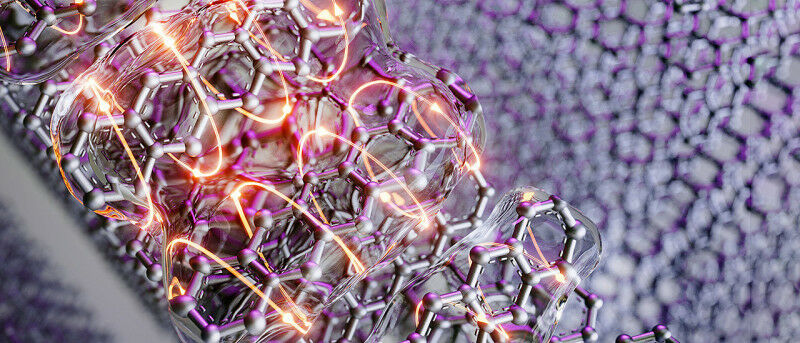一个光子如何变成四个电荷载流子
诸平
据德国维尔茨堡大学 / 维尔茨堡朱利叶斯-马克西米利安大学(University of Würzburg / Julius-Maximilians-Universität Würzburg)2023年4月14日提供的消息,一个光子如何变成四个电荷载流子(How one photon becomes four charge carriers)。相关研究结果于2023年4月12日已经在《自然》(Nature)杂志网站发表——Alexander Neef, Samuel Beaulieu, Sebastian Hammer, Shuo Dong, Julian Maklar, Tommaso Pincelli, R. Patrick Xian, Martin Wolf, Laurenz Rettig, Jens Pflaum, Ralph Ernstorfer. Orbital-resolved observation of singlet fission. Nature, Published: 12 April 2023, 616 (7956): 275-279. DOI:10.1038/s41586-023-05814-1. https://www.nature.com/articles/s41586-023-05814-1
参与此项研究的有来自德国柏林的马克斯·普朗克学会弗里茨·哈伯研究所(Fritz Haber Institute of the Max Planck Society, Berlin, Germany)、德国维尔茨堡朱利叶斯-马克西米利安大学(Julius-Maximilian University Wuerzburg, Wuerzburg, Germany)、德国柏林工业大学(Technical University Berlin, Berlin, Germany)、德国维尔茨堡巴瓦里安应用能源研究中心(Barvarian Centre for Applied Energy Research, Wuerzburg, Germany);法国波尔多大学(University of Bordeaux-CNRS-CEA, Bordeaux, France)、加拿大多伦多大学(University of Toronto, Toronto, Ontario, Canada)以及加拿大麦吉尔大学(McGill University, Montréal, Quebec, Canada)的研究人员。
一些材料将光子转化为比预期更多的自由电荷。使用超快胶片,研究人员现在已经能够获得这一过程的照片。维尔茨堡大学的物理学家也参与其中。
光伏(Photovoltaics),将光能转化为电能,是可持续能源的关键技术。自马克斯·普朗克(Max Planck)和阿尔伯特·爱因斯坦(Albert Einstein)时代以来,我们就知道光和电都以微小的量子化包形式出现,称为光子和基本电荷,后者以电子和空穴为代表。
激子分裂带来更好的太阳能电池(Better solar cells thanks to exciton splitting)
在普通的太阳能电池中,单个光子的能量被转移到材料中的自由电荷,但仅此而已。然而,并五苯(pentacene)等一些分子材料是个例外,它们显示一个光子转化为四个电荷。这种被称为激子解离(exciton fission)的激发倍增对高效光伏非常有用,特别是升级占主导地位的硅基技术(silicon-based technologies)。
马普学会弗里茨哈伯研究所(Fritz Haber Institute of the Max Planck Society)、柏林工业大学(Technical University of Berlin)和维尔茨堡朱利叶斯-马克西米利安大学(Julius-Maximilians-Universität Würzburg)的一组研究人员,现在已经通过录制光子到电的超快电影,破译了这一过程的第一步转换过程,解决了数十年来关于过程机制的争论。
该研究的资深作者拉尔夫·厄斯托费(Ralph Ernstorfer)教授解释说:“当并五苯被光激发时,材料中的电荷会迅速反应。一个被吸收的光子是直接激发两个电子和空穴,或者最初只激发一个电子-空穴对,随后与另一个电荷对共享能量,这是一个开放且极具争议的问题。” 拉尔夫·厄斯托费是弗里茨·哈伯研究所(Fritz Haber Institute)马克斯·普朗克研究小组(Max Planck research group)的负责人,也是柏林工业大学的实验物理学教授。
飞秒级的快照(Snapshots of one billionth of a millionth of a second)
为了揭开这个谜团,研究人员使用了时间和角度分辨光电发射光谱(timeand angle-resolved photoemission spectroscopy),这是一种在飞秒时间尺度(femtosecond time scale,1 fs or 10-15 s)内观察电子动力学的尖端技术。这种超快电子电影摄影机使他们能够首次捕捉到转瞬即逝的激发电子的图像。
该研究的第一作者、弗里茨·哈伯研究所的亚历山大·尼夫(Alexander Neef)说:“看到这些电荷载流子对(charge carrier pairs)对于破译这个过程至关重要。激发的电子空穴对不仅具有特定的能量,而且还适应被称为轨道的不同的模式。要了解单线态裂分(singlet fission)的过程,必须确定电荷载流子(charge carriers)的轨道形状以及它们如何随时间而变。”
对有机半导体的使用至关重要(Crucial for the use of organic semiconductors)
借助手头的超快电子电影图像,研究人员首次根据轨道特征分解了激发电荷载流子的动力学。“我们现在可以肯定地说,只有一个电子-空穴对在光子激发后立即被激发,并确定了自由电荷载流子翻倍过程的机制,”亚历山大·尼夫补充道。
“解决激子裂分(exciton fission)的这一初始步骤对于在创新光伏应用中成功实施此类有机半导体至关重要,从而进一步提高当今太阳能电池的转换效率”,延斯·普夫劳姆(Jens Pflaum)教授表示,他所在的维尔茨堡大学团队为这项研究提供了高质量的分子晶体。这种进步将产生巨大的影响,因为太阳能及其由这些第三代电池产生的能量将成为未来的主要能源。
本研究得到了德国马普学会(Max-Planck-Gesellschaft)和德国研究基金会(Deutsche Forschungsgemeinschaft简称DFG; German Research Foundation through the project no. 490894053)或者在埃米·诺特项目(Emmy Noether program grant no. RE 3977/1)及通过SFB951 (grant no. 1820877777, project B17) 和优先项目SPP2244(project 443366970)的资助。还有马克思·普朗克-瑞士洛桑联邦理工学院分子纳米科学与技术中心(Max Planck-EPFL Center for Molecular Nanoscience and Technology)和欧洲研究委员会(European Research Council简称ERC)下的欧盟地平线2020研究与创新计划{ European Union’s Horizon 2020 research and innovation program (grant no. ERC-2015-CoG-682843 and grant agreement No 899794)} 的资助。还有加拿大自然科学与工程研究理事会-班廷博士后研究项目(NSERC-Banting Postdoctoral Fellowship Program)、亚历山大·冯·洪堡基金会(Alexander von Humboldt Foundation)、巴伐利亚科学、研究和艺术部(太阳能技术混合合作研究网络){ Bavarian State Ministry of Science, Research, and the Arts (Collaborative Research Network ‘Solar Technologies Go Hybrid’)}的资助或者支持。
上述介绍,仅供参考。欲了解更多信息,敬请注意浏览原文或者相关报道。
Singlet fission1–13 may boost photovoltaic efficiency14–16 by transforming a singlet exciton into two triplet excitons and thereby doubling the number of excited charge carriers. The primary step of singlet fission is the ultrafast creation of the correlated triplet pair17. Whereas several mechanisms have been proposed to explain this step, none has emerged as a consensus. The challenge lies in tracking the transient excitonic states. Here we use time- and angle-resolved photoemission spectroscopy to observe the primary step of singlet fission in crystalline pentacene. Our results indicate a charge-transfer mediated mechanism with a hybridization of Frenkel and chargetransfer states in the lowest bright singlet exciton. We gained intimate knowledge about the localization and the orbital character of the exciton wave functions recorded in momentum maps. This allowed us to directly compare the localization of singlet and bitriplet excitons and decompose energetically overlapping states on the basis of their orbital character. Orbital- and localization-resolved many-body dynamics promise deep insights into the mechanics governing molecular systems18–20 and topological materials21–23.
转载本文请联系原作者获取授权,同时请注明本文来自诸平科学网博客。
链接地址:https://wap.sciencenet.cn/blog-212210-1384593.html?mobile=1
收藏


